Building Community Resiliency through Immersive Communal Extended Reality (CXR)
Abstract
:1. Introduction
- 1.
- An empirical contribution of the results from the inaugural real-world deployment of the CXR system with participants from the community.
- 2.
- A methodological contribution of a community engagement protocol. Our protocol suggests using a mass transport vehicle to simulate climate change scenarios. It included research team engagement with government officials to develop the system and design the experience and bring social groups and individuals from the community during the deployment process.
- 3.
- A practical contribution of a draft of a community resiliency plan based on the creative ideas and strategies discussed by the community.
2. Related Work
2.1. Community Engagement and Climate Change
- They bring stakeholders together to develop locally appropriate solutions tailored to that community’s specific needs and resources [18]. For example, Harvey et al. [19] describe how the Australian Coastcare program brought together local stakeholders in the decision making and management of coastal resources.
- They can help to identify local priorities for specific climate-change-related issues. Barron et al. [20] and Stevens et al. [21] describe using community engagement to gather input and feedback on proposed adaptation plans to prepare for the flooding and erosion caused by sea level rise in Vancouver, Canada and New South Wales, respectively.
- They enhance ownership and accountability of the initiatives. Krasny and DuBois [22] describe environmental education programs in post-Hurricane-Sandy New York City with planting events and educational tours about green infrastructure, such as wetlands, dunes, and oyster reefs.
2.2. VR for Climate Change Community Engagement
2.3. Challenges in Using VR for Community Engagement
3. Community Engagement Process and Timeline
3.1. Case Study on Roosevelt Island Community
3.2. Focus Group Activity Design
3.3. Experience Design
4. Method
4.1. Three-Part Group Activity
- 1.
- Pre-ride focus group and survey: A 30 min session on understanding the participant’s knowledge and thoughts about climate change and flood risks on RI before the ride.
- 2.
- The immersive CXR bus ride: A 30 min ride to complete a full circle around the island—half of the ride conducted through the geo-aligned cinematic movie, while participants wear HMDs VR, with the second half returning to the starting point, while the participants rest and contemplate.
- 3.
- Post-ride focus group and survey: A 30 min session aimed to learn if and how the experience changed participants’ knowledge, thoughts, and understanding of climate change and flood risks and to collect their ideas on practical actions toward developing a community resiliency plan.
4.2. The CXR System
4.3. Participants
4.4. Experience
5. Data Analysis
5.1. Thematic Coding of the Focus Groups Transcripts
- 1.
- Facilitation of the focus group through ice breakers and background information, such as the participants’ ties to RI and their prior knowledge of climate change and its effect on RI;
- 2.
- Feelings evoked by the ride;
- 3.
- Participant’s awareness of climate change;
- 4.
- Participant’s responses to the experience;
- 5.
- Strategies in different levels.
5.1.1. Behavioral Observations of the Bus Ride Videos
5.1.2. Quantitative Analysis of Survey Data
6. Results
6.1. Impacts of CXR on the Community
6.1.1. Education and Awareness
6.1.2. Bringing Community Members Together
6.1.3. Identifying Local Priorities
- Concern: “There are a lot of senior residents on the island.” Actionable idea: “Get people to be buddies with some of the older residents who live alone.” (G3B).
- Concern: “The one thing I took away from it is how useless cars are going to be.” Actionable idea: “Have a plan with your family. How are you going to connect? The meeting place where you’re going to go? Keep your documents together, list of your medications, emergency numbers, all that kind of stuff.” (G5B).
- Concern: “Not everybody knows how to understand alerts on their phone.” Actionable idea: “When I grow up we had an alarm system… It’s a small island, I imagine you could do something like that here…” (G5B).
6.1.4. Enhance Ownership and Accountability
6.2. The Advantages of CXR for Climate Change Community Engagement
6.2.1. The Immersive, Embodied Aspects—Making Climate Change Feel Real
6.2.2. The Situational Qualities—Bringing Climate Change Closer to Home
6.2.3. The Communal Aspects—Turning the Spotlight to the Community Resources
7. Discussion
- 1.
- It suggests an empirical contribution, with results from the first-of-its-kind, real-world deployment of the CXR system with participants from the community.
- 2.
- It offers a methodological contribution of a community engagement protocol, the unique opportunity to use mass transport vehicles as a venue to engage with communities in their familiar and most precious environment.
- 3.
- It makes a practical contribution in the form of a draft of a community resiliency plan. The draft in the Appendix A was collected through the focus group engagement protocol and can serve as a base for future development by the community.
7.1. Immersiveness Makes Climate Change Feel Real
7.2. Situational Qualities and Geo-Location Brings Climate Change Closer to Home
7.3. Communal Experience Highlights Existing Community Resources
7.4. Toward a Community Resiliency Plan
7.5. Limitations
7.6. Future Applications to Promote Community Awareness and Engagement
8. Conclusions
Author Contributions
Funding
Institutional Review Board Statement
Informed Consent Statement
Data Availability Statement
Acknowledgments
Conflicts of Interest
Abbreviations
| CXR | Communal Extended Reality |
| NYC | New York City |
| RI | Roosevelt Island |
| AR | Augmented Reality |
| VR | Virtual Reality |
| XR | Extended Reality |
| HMD | Head-Mounted Display |
| DT | Digital Twin |
| RIOC | Roosevelt Island Operating Corporation |
Appendix A. Initial Ideas for a Community Resiliency Plan
Appendix A.1. Growing Circles of Responsibility for Climate Resiliency
Appendix A.1.1. Household Circle
- Go-bags: Keep your documents together, including a list of your medications, emergency numbers, IDs, passports, medical insurance, and so forth.
- Stay-bags: In case there is a need to shelter in place, prepare a kit with canned food, water, flashlights, batteries, plastic sheeting, duct tape, toilet paper, whistle, light sticks, blankets, etc. (these two lists, are initial thoughts that need to be improved by professionals).
- Family meet-up: Have a plan with your family. How are you going to connect? Where will be the meeting place where you will meet?
Appendix A.1.2. Building Circle
- Floor level: Check on your neighbor who shares the same floor by knocking on the door. Meet in the hallway and make sure everyone is okay and has enough supply. Make sure to keep communicating throughout the emergency. If someone is in need, reach out to the building management for help.
- Higher floors assist lower floors: In case of damage to the lower floors at higher risk for flood, be prepared to host your lower floor neighbors.
- Building information: The building’s management should communicate all news and announcements through the building apps. There should be a non-electric, non-technical way to communicate information during an emergency when there is a power outage or for people who do not have access to computers, such as printouts and voice announcements.
- Building flood drills: Each building should have well-communicated and practiced flood drills renewed on an annual basis to accommodate newcomers and keep all island residents up to date with the information on what to do during a flood.
Appendix A.1.3. Community Circle
- Coordination between buildings: In the event of a flood, each building becomes a silo. However, there should be a way to communicate and coordinate activities and sharing of resources. Each building’s management should appoint an employee responsible for flood preparedness who will become a part of an island-scale network that will share resources and updates with their building tenants during a flood.
- Social groups: The island has many active social groups; those could be a go-to address in case of a flood. The leaders of each social group should be informed on how to act and be responsible for communicating information to their group members.
- Flood emergency committee: Some of the island’s residents, such as front-line workers, health care workers, or other relevant skills, are experts in their field. Those people have proved to be very helpful during past emergencies. The participant recommended creating a committee of willing certified experts who will be available to assist with resources and guides to the community during a flood.
- Flood preparedness advocates: Create an advocacy group out of the research participants to reach out to the island’s operating corporation to advance some of the ideas brought up by the community to lead to long-term preparedness activities. This group could also be useful in reaching out to higher-level governmental authorities to allocate funds and resources to better prepare the island’s infrastructure for future sea level rise.
- Flood vulnerable community members list: Create a contact list of people dependent on ventilators or living alone to reach out to them in an emergency.
- “Buddies” program: That will match younger people or families with senior citizens or other residents who live alone to make sure those are being taken care of during an emergency.
Appendix A.1.4. Governance Circle
- An evacuation plan: There should be a clear and communicated emergency evacuation plan. The content of this plan should be shared with the residents.
- Education in advance: Should start as soon as possible by reaching out to the community using relatable and everyday activities like gardening. There should be awareness-raising activities, such as informative movies, to prevent a chaotic situation in times of flood.
- Climate change training sessions: Should be offered in public locations and advertised in order to include different and varied people from the community.
- Annual flood drills: These will be performed and include all circles of responsibilities elaborated above.
Appendix A.1.5. Creative Ideas to Be Further Explored
- Lifeboats: Can be placed around the island like those who are placed on a ship to enable quick evacuation.
- An evacuation elevator: Could be installed at the bottom of the Queensborough Bridge to enable quick evacuation.
- A digital twin for emergency control: Populate our island-scale digital twin with the list of vulnerable community members list and the Buddies program to be able to locate the people in need during a flood. Those people can be supplied with a call mechanism that will light an alarm in the digital twin when they use it.
- Flood alerts: A sound system that communicates emergencies in case of cellular network failure. An alarm system that can be heard all over the island with speakers can inform people on how to act in an emergency. This will make sure people with no cell phone, TV, or other media will receive the information too.
References
- McKinley, E.; Crowe, P.; Stori, F.; Ballinger, R.; Brew, T.; Blacklaw-Jones, L.; Cameron-Smith, A.; Crowley, S.; Cocco, C.; O’Mahony, C.; et al. ‘Going digital’-Lessons for future coastal community engagement and climate change adaptation. Ocean. Coast. Manag. 2021, 208, 105629. [Google Scholar] [CrossRef]
- Wiseman, J.; Williamson, L.; Fritze, J. Community engagement and climate change: Learning from recent Australian experience. Int. J. Clim. Chang. Strateg. Manag. 2010, 2, 134–147. [Google Scholar] [CrossRef]
- Head, B.W. Community engagement: Participation on whose terms? Aust. J. Political Sci. 2007, 42, 441–454. [Google Scholar] [CrossRef]
- Cubasch, U.; Meehl, G.; Boer, G.; Stouffer, R.; Dix, M.; Noda, A.; Senior, C.; Raper, S.; Yap, K. Projections of future climate change. In Climate Change 2001: The Scientific Basis. Contribution of WG1 to the Third Assessment Report of the IPCC (TAR); Cambridge University Press: Cambridge, UK, 2001; pp. 525–582. [Google Scholar]
- Kelman, I. Hearing local voices from small island developing states for climate change. Local Environ. 2010, 15, 605–619. [Google Scholar] [CrossRef]
- Lazrus, H. Sea change: Island communities and climate change. Annu. Rev. Anthropol. 2012, 41, 285–301. [Google Scholar] [CrossRef]
- Moser, S.C. Communicating adaptation to climate change: The art and science of public engagement when climate change comes home. Wiley Interdiscip. Rev. Clim. Chang. 2014, 5, 337–358. [Google Scholar] [CrossRef]
- Winn, M.; Kirchgeorg, M.; Griffiths, A.; Linnenluecke, M.K.; Günther, E. Impacts from climate change on organizations: A conceptual foundation. Bus. Strategy Environ. 2011, 20, 157–173. [Google Scholar] [CrossRef]
- Kiem, A.S.; Austin, E.K. Drought and the future of rural communities: Opportunities and challenges for climate change adaptation in regional Victoria, Australia. Glob. Environ. Chang. 2013, 23, 1307–1316. [Google Scholar] [CrossRef]
- Markowitz, D.M.; Laha, R.; Perone, B.P.; Pea, R.D.; Bailenson, J.N. Immersive virtual reality field trips facilitate learning about climate change. Front. Psychol. 2018, 9, 2364. [Google Scholar] [CrossRef]
- McLean, J.H.; Taladay, K.; Dong, J. A VR Environment for Demonstrating the Impact of Sea Level Rise on Hawai‘i. In Proceedings of the Practice and Experience in Advanced Research Computing, Portland, OR, USA, 26–30 July 2020; PEARC ’20. pp. 553–554. [Google Scholar]
- Moser, S.C.; Dilling, L. Creating a Climate for Change: Communicating Climate Change and Facilitating Social Change; Cambridge University Press: Cambridge, UK, 2007. [Google Scholar]
- Biggs, H.R.; Desjardins, A. High Water Pants: Designing Embodied Environmental Speculation. In Proceedings of the 2020 CHI Conference on Human Factors in Computing Systems (CHI’20), Online, 25–30 April 2020; pp. 1–13. [CrossRef]
- Breves, P.; Schramm, H. Bridging psychological distance: The impact of immersive media on distant and proximal environmental issues. Comput. Hum. Behav. 2021, 115, 106606. [Google Scholar] [CrossRef]
- Figueiredo, P.; Perkins, P.E. Women and water management in times of climate change: Participatory and inclusive processes. J. Clean. Prod. 2013, 60, 188–194. [Google Scholar] [CrossRef]
- Hoque, M.E.; Sarkar, S. Suitability analysis of reflective learning network for indigenous ‘Climate Change Adaptation’communication: A case study of Bangladesh coast. In Proceedings of the Boulder History and Philosophy of Climate Science Conference; University of Colorado: Boulder, CO, USA, 2012. [Google Scholar]
- Mirauda, D.; Capece, N.; Erra, U. Sustainable water management: Virtual reality training for open-channel flow monitoring. Sustainability 2020, 12, 757. [Google Scholar] [CrossRef]
- Jacquet, J.B.; Stedman, R.C. The risk of social-psychological disruption as an impact of energy development and environmental change. J. Environ. Plan. Manag. 2014, 57, 1285–1304. [Google Scholar] [CrossRef]
- Harvey, N.; Clarke, B.D.; Carvalho, P. The role of the Australian Coastcare program in community-based coastal management: A case study from South Australia. Ocean. Coast. Manag. 2001, 44, 161–181. [Google Scholar] [CrossRef]
- Barron, S.; Canete, G.; Carmichael, J.; Flanders, D.; Pond, E.; Sheppard, S.; Tatebe, K. A climate change adaptation planning process for low-lying, communities vulnerable to sea level rise. Sustainability 2012, 4, 2176–2208. [Google Scholar] [CrossRef]
- Stevens, H.; Dufty, N.; Waters, S.; Giles, G. Sea no evil, hear no evil–community engagement on adaptation to sea level change. In Proceedings of the 21st NSW Coastal Conference, Kiama, NSW, Australia, 6–9 November 2012. [Google Scholar]
- Krasny, M.E.; DuBois, B. Climate adaptation education: Embracing reality or abandoning environmental values. Environ. Educ. Res. 2019, 25, 883–894. [Google Scholar] [CrossRef]
- McKenzie, L.; Long, L.; Coles, R.; Roder, C. Seagrass-Watch: Community based monitoring of seagrass resources. Biol. Mar. Mediterr. 2000, 7, 393–396. [Google Scholar]
- Reed, G.; Brunet, N.D.; Natcher, D.C. Can indigenous community-based monitoring act as a tool for sustainable self-determination? Extr. Ind. Soc. 2020, 7, 1283–1291. [Google Scholar] [CrossRef]
- Sæþórsdóttir, A.D.; Ólafsdóttir, R. Not in my back yard or not on my playground: Residents and tourists’ attitudes towards wind turbines in Icelandic landscapes. Energy Sustain. Dev. 2020, 54, 127–138. [Google Scholar] [CrossRef]
- Wamsler, C.; Alkan-Olsson, J.; Björn, H.; Falck, H.; Hanson, H.; Oskarsson, T.; Simonsson, E.; Zelmerlow, F. Beyond participation: When citizen engagement leads to undesirable outcomes for nature-based solutions and climate change adaptation. Clim. Chang. 2020, 158, 235–254. [Google Scholar] [CrossRef]
- Thaker, J.; Howe, P.; Leiserowitz, A.; Maibach, E. Perceived collective efficacy and trust in government influence public engagement with climate change-related water conservation policies. Environ. Commun. 2019, 13, 681–699. [Google Scholar] [CrossRef]
- McDonald, R.I.; Chai, H.Y.; Newell, B.R. Personal experience and the ‘psychological distance’of climate change: An integrative review. J. Environ. Psychol. 2015, 44, 109–118. [Google Scholar] [CrossRef]
- Zander, K.K.; Petheram, L.; Garnett, S.T. Stay or leave? Potential climate change adaptation strategies among Aboriginal people in coastal communities in northern Australia. Nat. Hazards 2013, 67, 591–609. [Google Scholar] [CrossRef]
- Shepherd, S.; Kay, A.C. On the perpetuation of ignorance: System dependence, system justification, and the motivated avoidance of sociopolitical information. J. Personal. Soc. Psychol. 2012, 102, 264. [Google Scholar] [CrossRef] [PubMed]
- Sheppard, S.R. Making climate change visible: A critical role for landscape professionals. Landsc. Urban Plan. 2015, 142, 95–105. [Google Scholar] [CrossRef]
- Scurati, G.W.; Bertoni, M.; Graziosi, S.; Ferrise, F. Exploring the use of virtual reality to support environmentally sustainable behavior: A framework to design experiences. Sustainability 2021, 13, 943. [Google Scholar] [CrossRef]
- Portman, M.E.; Natapov, A.; Fisher-Gewirtzman, D. To go where no man has gone before: Virtual reality in architecture, landscape architecture and environmental planning. Comput. Environ. Urban Syst. 2015, 54, 376–384. [Google Scholar] [CrossRef]
- Herscher, S.; Perlin, K.; Layng, K. Shared Room Scale Virtual and Mixed Reality Storytelling for a Multi-Person Audience that May Be Physically Co-Located. U.S. Patent 11,508,128, 21 September 2018. [Google Scholar]
- Wu, J.S.; Lee, J.J. Climate change games as tools for education and engagement. Nat. Clim. Chang. 2015, 5, 413–418. [Google Scholar] [CrossRef]
- Hsu, W.C.; Tseng, C.M.; Kang, S.C. Using exaggerated feedback in a virtual reality environment to enhance behavior intention of water-conservation. J. Educ. Technol. Soc. 2018, 21, 187–203. [Google Scholar]
- Markowitz, D.M.; Bailenson, J.N. Virtual reality and the psychology of climate change. Curr. Opin. Psychol. 2021, 42, 60–65. [Google Scholar] [CrossRef]
- Stone, N.J.; Yan, G.; Nah, F.F.H.; Sabharwal, C.; Angle, K.; Hatch III, F.G.E.; Runnels, S.; Brown, V.; Schoor, G.M.; Engelbrecht, C.; et al. Virtual reality for hazard mitigation and community resilience: An interdisciplinary collaboration with community engagement to enhance risk awareness. AIS Trans.—Hum. Comput. Interact. 2021, 13, 130–144. [Google Scholar] [CrossRef]
- Fauville, G.; Queiroz, A.C.; Hambrick, L.; Brown, B.A.; Bailenson, J.N. Participatory research on using virtual reality to teach ocean acidification: A study in the marine education community. Environ. Educ. Res. 2021, 27, 254–278. [Google Scholar] [CrossRef]
- Botev, J.; Viegas, A. Forest SaVR-A Virtual-Reality Application to Raise Awareness of Deforestation. In Proceedings of the GI VR/AR Workshop, Trier, Germany, 24–25 September 2020; Gesellschaft für Informatik eV: Bonn, Germany, 2020. [Google Scholar]
- Straßmann, C.; Arntz, A.; Eimler, S.C. Under The (Plastic) Sea-Sensitizing People Toward Ecological Behavior Using Virtual Reality Controlled by Users’ Physical Activity. In Proceedings of the 2020 IEEE International Conference on Artificial Intelligence and Virtual Reality (AIVR), Utrecht, The Netherlands, 14–18 December 2020; IEEE: New York, NY, USA, 2020; pp. 166–173. [Google Scholar]
- Calil, J.; Fauville, G.; Queiroz, A.C.M.; Leo, K.L.; Newton Mann, A.G.; Wise-West, T.; Salvatore, P.; Bailenson, J.N. Using Virtual Reality in Sea Level Rise Planning and Community Engagement—An Overview. Water 2021, 13, 1142. [Google Scholar] [CrossRef]
- Jude, S.; Mokrech, M.; Walkden, M.; Thomas, J.; Koukoulas, S. Visualising potential coastal change: Communicating results using visualisation techniques. In Broad Scale Coastal Simulation; Springer: Dordrecht, The Netherlands, 2015; pp. 255–272. [Google Scholar]
- Gleasure, R.; Feller, J. A rift in the ground: Theorizing the evolution of anchor values in crowdfunding communities through the oculus rift case study. J. Assoc. Inf. Syst. 2016, 17, 1. [Google Scholar] [CrossRef]
- Marques, B.; Silva, S.; Alves, J.; Araujo, T.; Dias, P.; Santos, B.S. A conceptual model and taxonomy for collaborative augmented reality. IEEE Trans. Vis. Comput. Graph. 2021, 28, 5113–5133. [Google Scholar] [CrossRef]
- Speicher, M.; Hall, B.D.; Nebeling, M. What is mixed reality? In Proceedings of the 2019 CHI Conference on Human Factors in Computing Systems, Scotland, UK, 4–9 May 2019; pp. 1–15. [Google Scholar]
- Sereno, M.; Wang, X.; Besançon, L.; Mcguffin, M.J.; Isenberg, T. Collaborative work in augmented reality: A survey. IEEE Trans. Vis. Comput. Graph. 2020, 28, 2530–2549. [Google Scholar] [CrossRef]
- Drey, T.; Albus, P.; der Kinderen, S.; Milo, M.; Segschneider, T.; Chanzab, L.; Rietzler, M.; Seufert, T.; Rukzio, E. Towards collaborative learning in virtual reality: A comparison of co-located symmetric and asymmetric pair-learning. In Proceedings of the Proceedings of the 2022 CHI Conference on Human Factors in Computing Systems, Orleans, LA, USA, 29 April–5 May 2022; pp. 1–19. [Google Scholar]
- Gunkel, S.; Stokking, H.; Prins, M.; Niamut, O.; Siahaan, E.; Cesar, P. Experiencing virtual reality together: Social VR use case study. In Proceedings of the 2018 ACM International Conference on Interactive Experiences for TV and Online Video, Seoul, Republic of Korea, 27–29 June 2018; pp. 233–238. [Google Scholar]
- Ketzler, B.; Naserentin, V.; Latino, F.; Zangelidis, C.; Thuvander, L.; Logg, A. Digital twins for cities: A state of the art review. Built Environ. 2020, 46, 547–573. [Google Scholar] [CrossRef]
- Xia, H.; Liu, Z.; Maria, E.; Liu, X.; Lin, C. Study on City Digital Twin Technologies for Sustainable Smart City Design: A Review and Bibliometric Analysis of Geographic Information System and Building Information Modeling Integration. Sustain. Cities Soc. 2022, 84, 104009. [Google Scholar] [CrossRef]
- Dembski, F.; Wössner, U.; Letzgus, M.; Ruddat, M.; Yamu, C. Urban digital twins for smart cities and citizens: The case study of Herrenberg, Germany. Sustainability 2020, 12, 2307. [Google Scholar] [CrossRef]
- Küsel, K. Model-Based System Engineering for Life Cycle Development of Digital Twins of Real Estate. In Proceedings of the INCOSE International Symposium, Virtual, 20–22 July 2020; Volume 30, pp. 715–730. [Google Scholar]
- Lehtola, V.V.; Koeva, M.; Elberink, S.O.; Raposo, P.; Virtanen, J.P.; Vahdatikhaki, F.; Borsci, S. Digital twin of a city: Review of technology serving city needs. Int. J. Appl. Earth Obs. Geoinf. 2022, 114, 102915. [Google Scholar] [CrossRef]
- Shahat, E.; Hyun, C.T.; Yeom, C. City digital twin potentials: A review and research agenda. Sustainability 2021, 13, 3386. [Google Scholar] [CrossRef]
- Abdeen, F.N.; Sepasgozar, S.M. City digital twin concepts: A vision for community participation. Environ. Sci. Proc. 2022, 12, 19. [Google Scholar]
- Ens, B.; Lanir, J.; Tang, A.; Bateman, S.; Lee, G.; Piumsomboon, T.; Billinghurst, M. Revisiting collaboration through mixed reality: The evolution of groupware. Int. J.—Hum. Comput. Stud. 2019, 131, 81–98. [Google Scholar] [CrossRef]
- Marques, B.; Silva, S.; Dias, P.; Santos, B.S. One-to-many remote scenarios: The next step in collaborative extended reality (XR) research. In Proceedings of the Workshop on Analytics, Learning & Collaboration in eXtended Reality (XR-WALC), ACM International Conference on Interactive Media Experiences (IMX 2022), Aveiro, Portugal, 22–24 June 2022; pp. 1–6. [Google Scholar]
- Johnson, P.; Burgee, J. The Island Nobody Knows; New York State Urban Development Corporation Metropolitan Museum of Art: New York, NY, USA, 1969. [Google Scholar]
- Yavo-Ayalon, S. Leaving room for the social in a neoliberal economic current: Three phases of urban planning for Roosevelt Island, NYC. Cities 2022, 124, 103580. [Google Scholar] [CrossRef]
- Yavo-Ayalon, S. Privatization and its aftermath: Are we facing a new displacement force? J. Urban Manag. 2022, 11, 285–297. [Google Scholar] [CrossRef]
- Braun, V.; Clarke, V. Thematic Analysis; American Psychological Association: Washington, DC, USA, 2012. [Google Scholar]
- Lee, G.; Wei, Q.; Zhu, Y. Emerging wearable sensors for plant health monitoring. Adv. Funct. Mater. 2021, 31, 2106475. [Google Scholar] [CrossRef]
- Barteit, S.; Boudo, V.; Ouedraogo, A.; Zabré, P.; Ouremi, L.; Sié, A.; Munga, S.; Obor, D.; Kwaro, D.; Huhn, S.; et al. Feasibility, acceptability and validation of wearable devices for climate change and health research in the low-resource contexts of Burkina Faso and Kenya: Study protocol. PLoS ONE 2021, 16, e0257170. [Google Scholar] [CrossRef]
- Nochta, T.; Wan, L.; Schooling, J.M.; Parlikad, A.K. A socio-technical perspective on urban analytics: The case of city-scale digital twins. J. Urban Technol. 2021, 28, 263–287. [Google Scholar] [CrossRef]
- Lv, Z.; Chen, D.; Lv, H. Smart city construction and management by digital twins and BIM big data in COVID-19 scenario. ACM Trans. Multimid. Comput. Commun. Appl. 2022, 18, 117. [Google Scholar] [CrossRef]
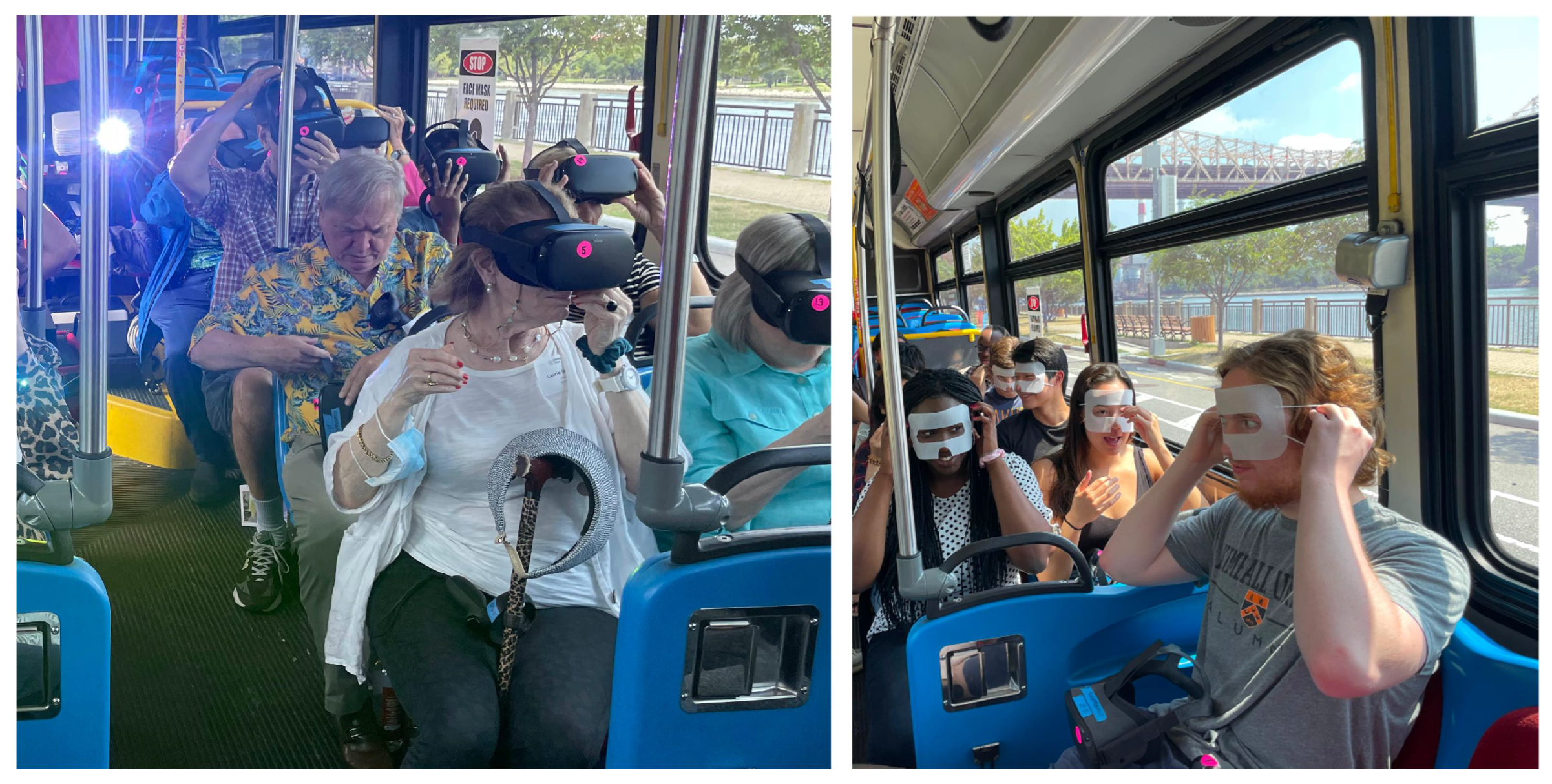
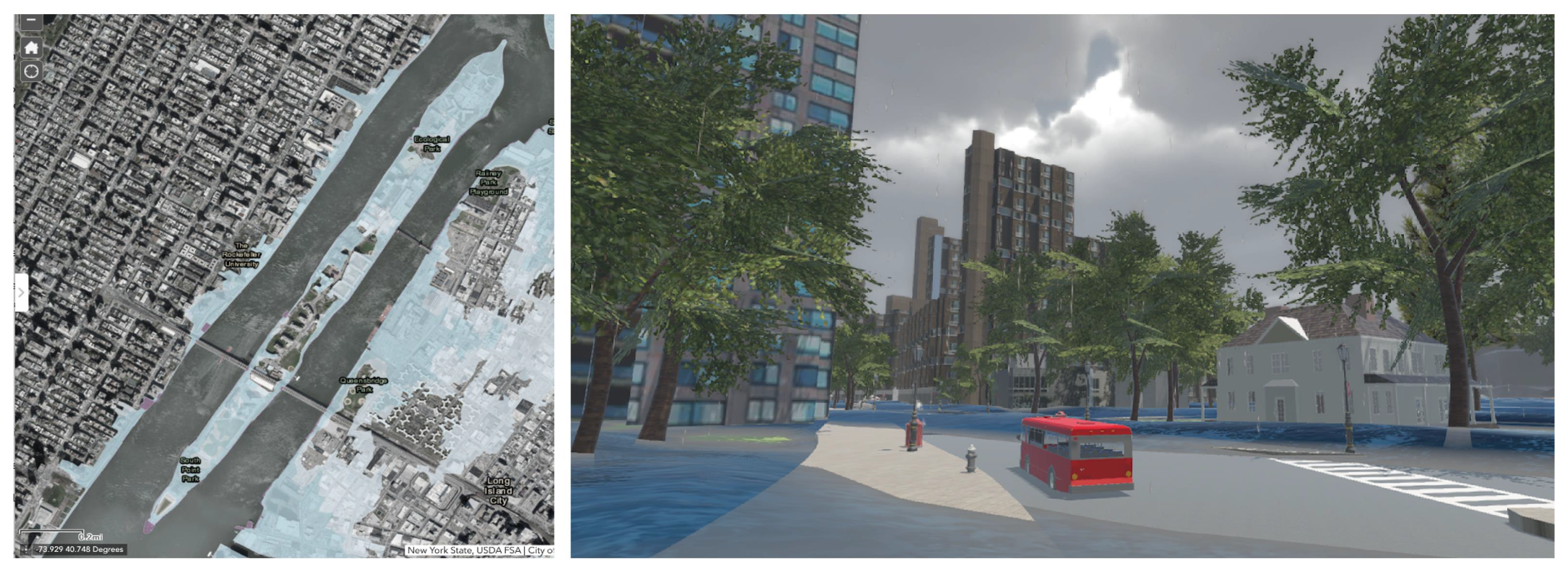


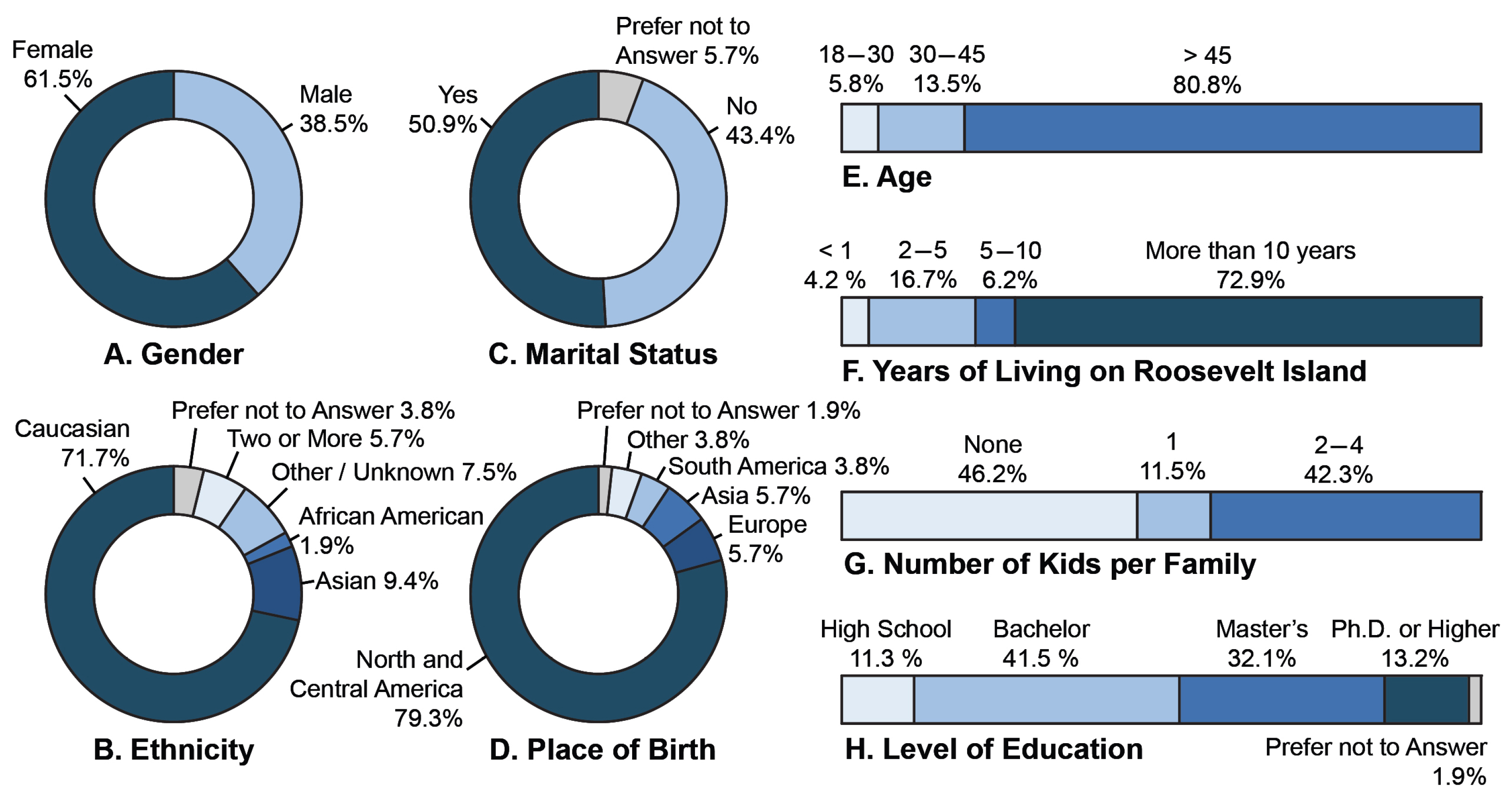
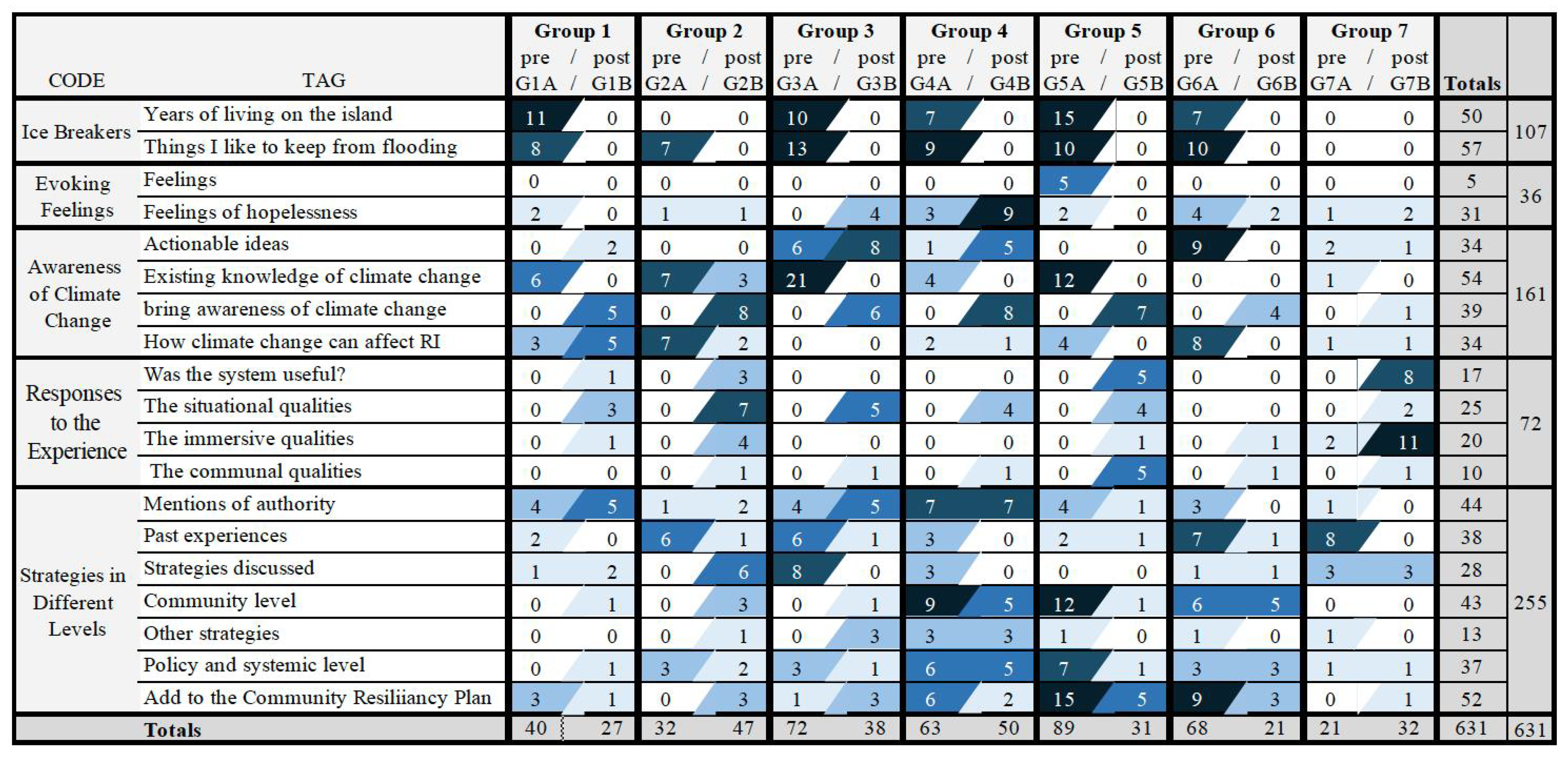
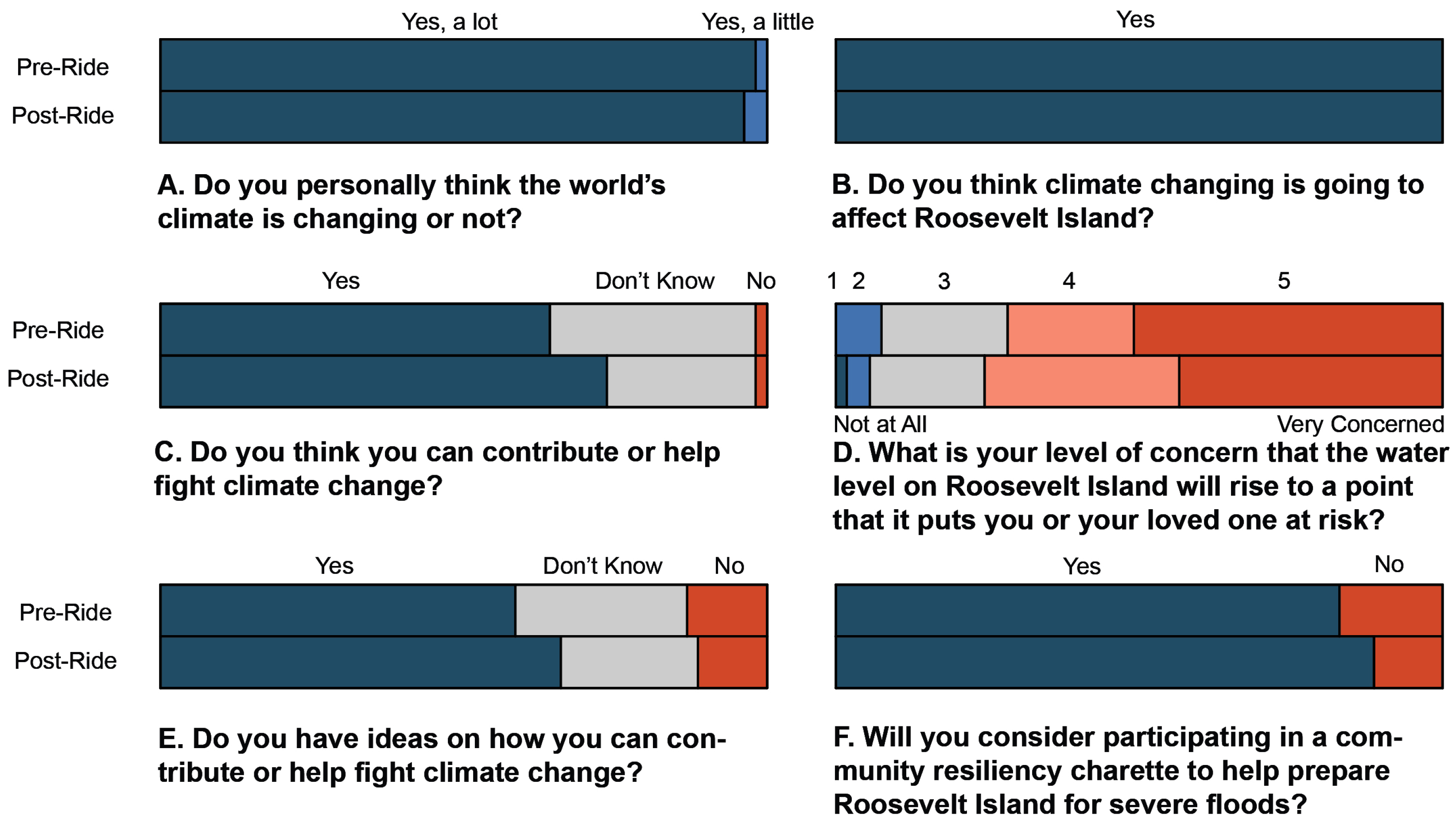

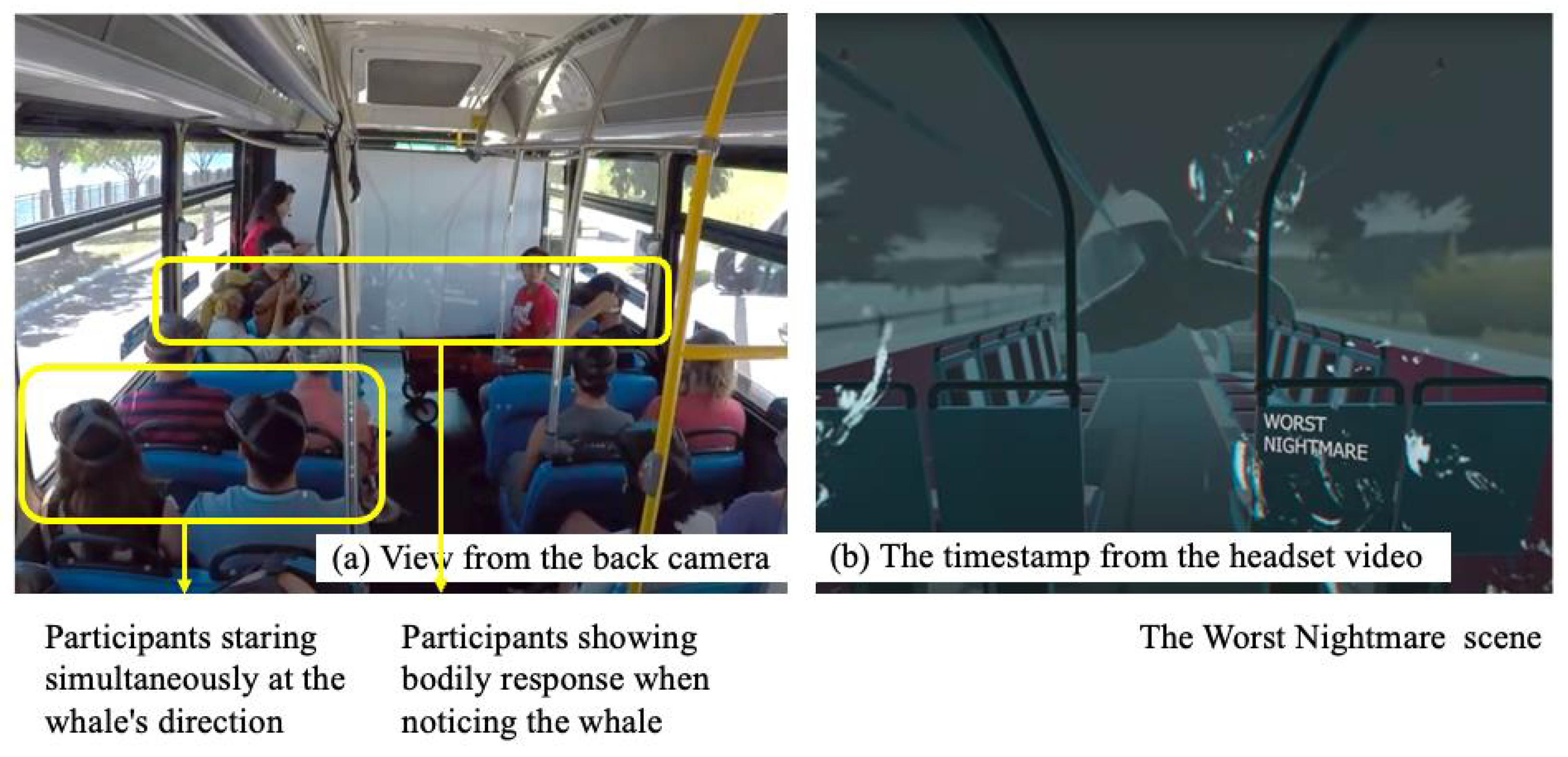

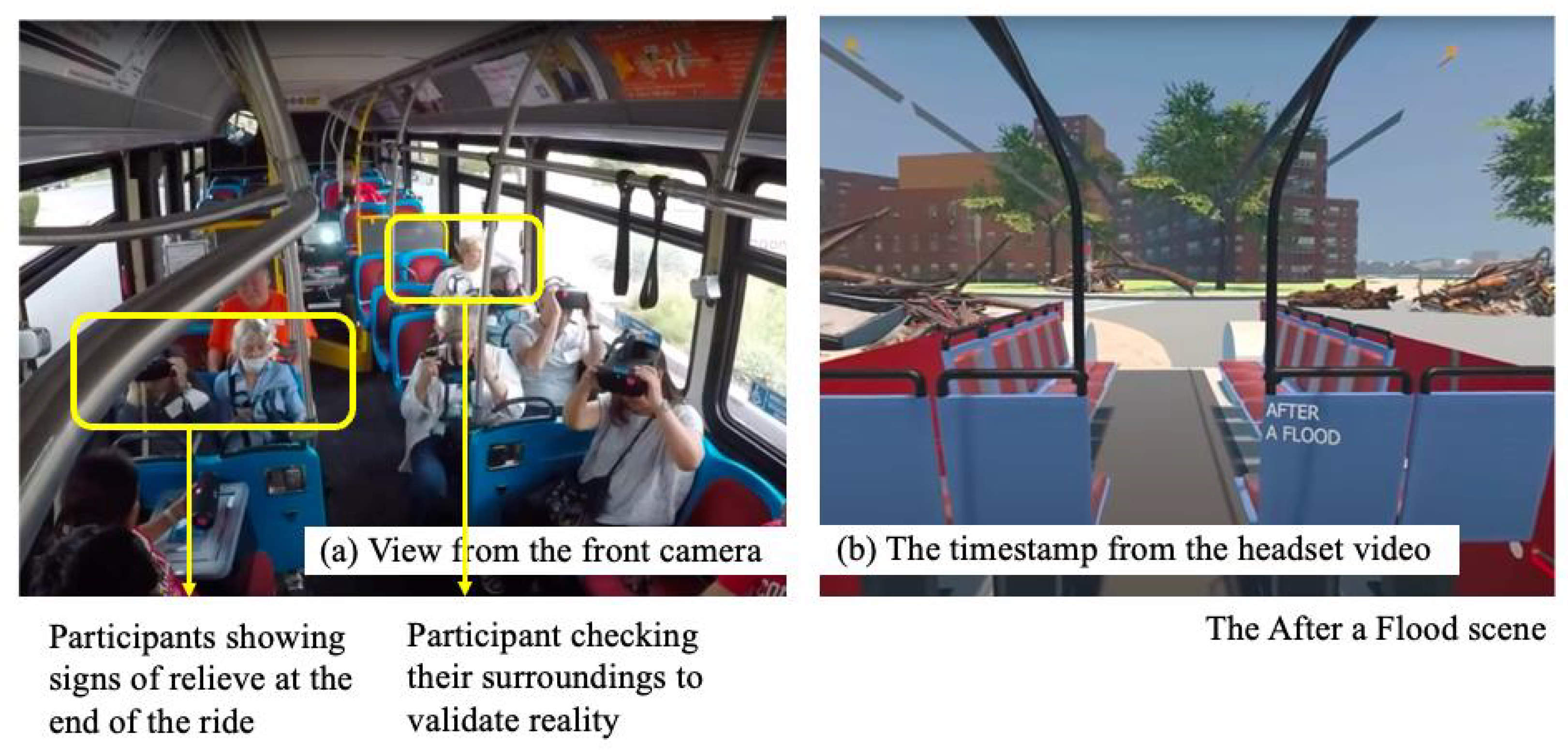
| Dates | Phase | Activity | Outcomes |
|---|---|---|---|
| November 2021–January 2022 | Preliminary Research | Meetings with climate change experts, urban designers, and city officials to learn about the needs and existing tools. | Executive summary with main objectives. Draft script for the immersive experience. |
| February 2022–May 2022 | Development | Developing the immersive experience using Unity. Running test drives to check the efficacy of the experience. Developing the questioners of before and after the experience. | A prototype of the immersive experience. |
| June 2022–August 2022 | Experiment | Running 7 RIOC shuttle bus ride with 15 people in each, followed by focus group. | Data sets composed of videos |
| September 2022–October 2022 | Analysis | Analyze data and footage captured from the experiment. Observing changes in point of view and understanding possible causal factors. | Policy report Immersive exercise for RIOC to share with the residents. |
Disclaimer/Publisher’s Note: The statements, opinions and data contained in all publications are solely those of the individual author(s) and contributor(s) and not of MDPI and/or the editor(s). MDPI and/or the editor(s) disclaim responsibility for any injury to people or property resulting from any ideas, methods, instructions or products referred to in the content. |
© 2023 by the authors. Licensee MDPI, Basel, Switzerland. This article is an open access article distributed under the terms and conditions of the Creative Commons Attribution (CC BY) license (https://creativecommons.org/licenses/by/4.0/).
Share and Cite
Yavo-Ayalon, S.; Joshi, S.; Zhang, Y.; Han, R.; Mahyar, N.; Ju, W. Building Community Resiliency through Immersive Communal Extended Reality (CXR). Multimodal Technol. Interact. 2023, 7, 43. https://doi.org/10.3390/mti7050043
Yavo-Ayalon S, Joshi S, Zhang Y, Han R, Mahyar N, Ju W. Building Community Resiliency through Immersive Communal Extended Reality (CXR). Multimodal Technologies and Interaction. 2023; 7(5):43. https://doi.org/10.3390/mti7050043
Chicago/Turabian StyleYavo-Ayalon, Sharon, Swapna Joshi, Yuzhen (Adam) Zhang, Ruixiang (Albert) Han, Narges Mahyar, and Wendy Ju. 2023. "Building Community Resiliency through Immersive Communal Extended Reality (CXR)" Multimodal Technologies and Interaction 7, no. 5: 43. https://doi.org/10.3390/mti7050043
APA StyleYavo-Ayalon, S., Joshi, S., Zhang, Y., Han, R., Mahyar, N., & Ju, W. (2023). Building Community Resiliency through Immersive Communal Extended Reality (CXR). Multimodal Technologies and Interaction, 7(5), 43. https://doi.org/10.3390/mti7050043






